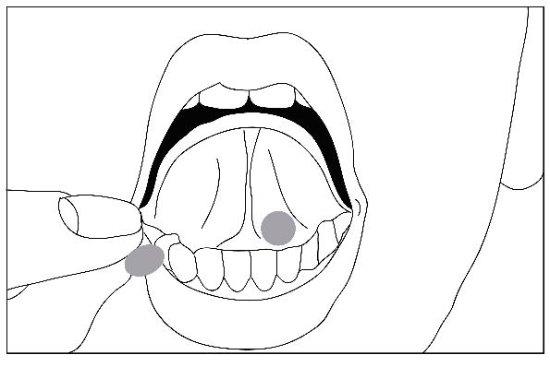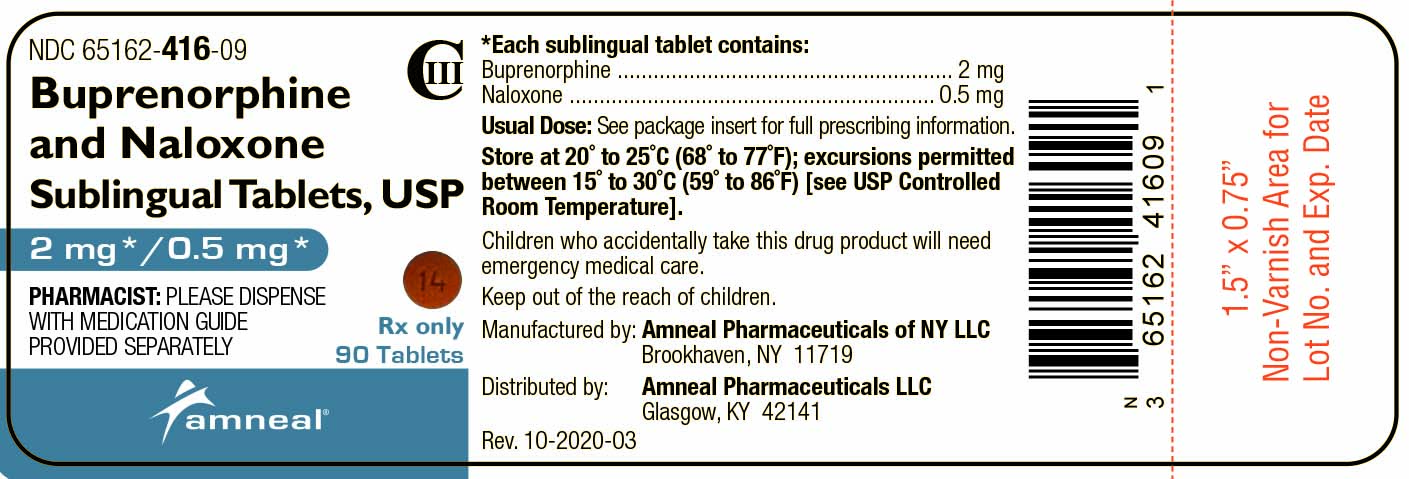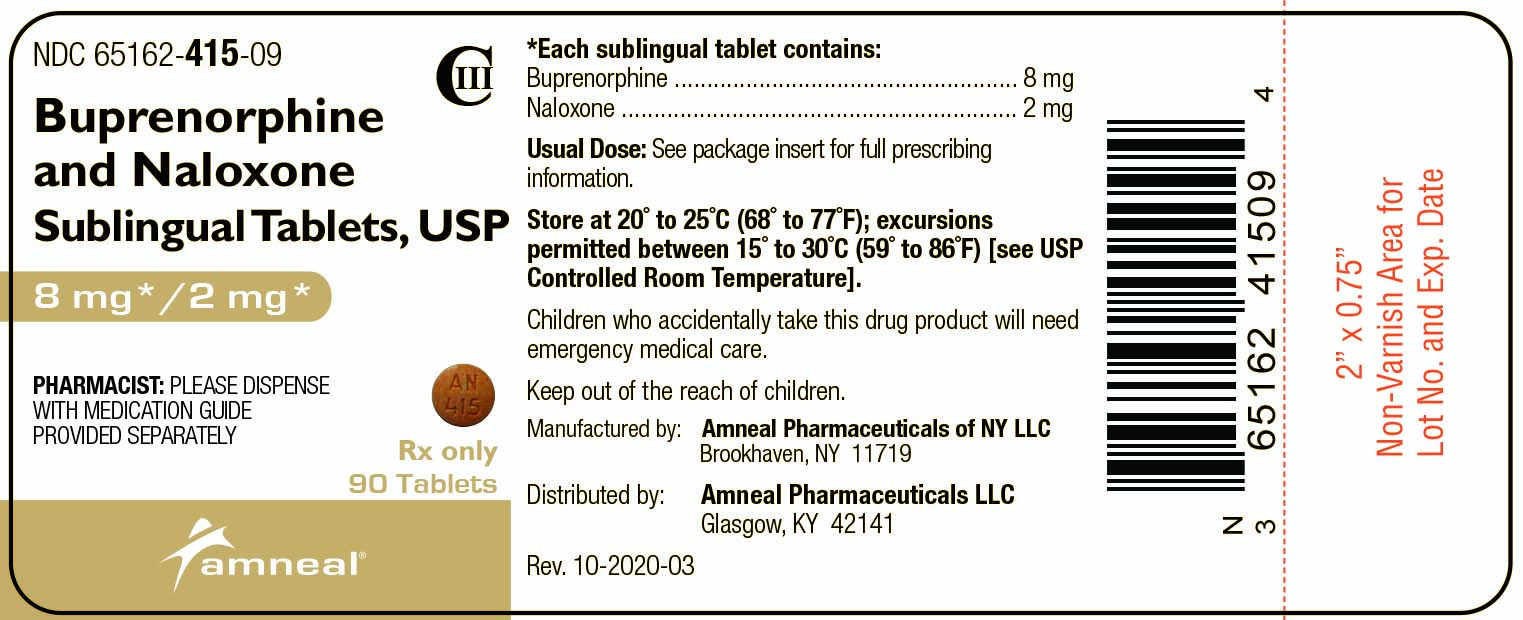Drug Catalog - Product Detail
BUPRENORPHINE-NALOXONE SL TAB 2-0.5MG 30CT
| NDC | Mfr | Size | Str | Form |
|---|---|---|---|---|
| 65162-0416-03 | AMNEAL PHARMACEUTICALS | 30 | 2-0.5MG | TABLET |
PACKAGE FILES





Generic Name
BUPRENORPHINE AND NALOXONE
Substance Name
BUPRENORPHINE HYDROCHLORIDE
Product Type
HUMAN PRESCRIPTION DRUG
Route
SUBLINGUAL
Application Number
ANDA203136
Description
11 DESCRIPTION Buprenorphine and naloxone sublingual tablet USP, 2 mg/0.5 mg is an orange, round, biconvex tablet debossed “A” on one side and “14” on the other side. Buprenorphine and naloxone sublingual tablet USP, 8 mg/2 mg is an orange, round, biconvex tablet debossed “AN 415” on one side and plain on the other side. They contain buprenorphine HCl, USP, a partial agonist at the mu-opioid receptor, and naloxone HCl dihydrate, USP, an opioid receptor antagonist, at a ratio of 4:1 (ratio of free bases). It is intended for sublingual administration and is available in two dosage strengths, 2 mg buprenorphine with 0.5 mg naloxone and 8 mg buprenorphine with 2 mg naloxone. Each sublingual tablet also contains the following inactive ingredients: acesulfame potassium, anhydrous citric acid, artificial lemon flavor, FD&C Yellow No. 6 Aluminum Lake, lactose monohydrate, magnesium stearate, mannitol, povidone, sodium citrate and starch (corn starch). Chemically, buprenorphine HCl, USP is (2S)-2-[17-Cyclopropylmethyl-4,5α-epoxy-3-hydroxy-6-methoxy-6α,14-ethano-14α-morphinan-7α-yl]-3,3-dimethylbutan-2-ol hydrochloride. It has the following chemical structure: Buprenorphine HCl, USP has the molecular formula C 29 H 41 NO 4 • HCl and the molecular weight is 504.10. It is a white or off-white crystalline powder, sparingly soluble in water, freely soluble in methanol, soluble in alcohol, and practically insoluble in cyclohexane. Chemically, naloxone HCl dihydrate, USP is 17-Allyl-4, 5 α -epoxy-3, 14-dihydroxymorphinan-6-one hydrochloride dihydrate. It has the following chemical structure: Naloxone hydrochloride dihydrate, USP has the molecular formula C 19 H 21 NO 4 • HCl • 2H 2 O and the molecular weight is 399.87. It is a white to slightly off-white powder and is freely soluble in water, soluble in alcohol, and practically insoluble in toluene and ether. 561287c0-figure-01 561287c0-figure-02
How Supplied
16 HOW SUPPLIED/STORAGE AND HANDLING Buprenorphine and Naloxone Sublingual Tablets USP, 2 mg/0.5 mg are supplied as orange, round, biconvex tablet, debossed “A” on one side and “14” on the other side. They are available as follows: Bottles of 30 NDC 65162-416-03 Bottles of 90 NDC 65162-416-09 Buprenorphine and Naloxone Sublingual Tablets USP, 8 mg/2 mg are supplied as orange, round, biconvex tablet debossed “AN 415” on one side and plain on the other side. They are available as follows: Bottles of 30 NDC 65162-415-03 Bottles of 90 NDC 65162-415-09 Store at 20° to 25°C (68° to 77°F); excursions permitted between 15° to 30°C (59° to 86°F) [see USP Controlled Room Temperature]. Store Buprenorphine and Naloxone Sublingual Tablets, USP securely and dispose of properly [see Patient Counseling Information (17) ] .
Indications & Usage
1 INDICATIONS AND USAGE Buprenorphine and Naloxone Sublingual Tablets are indicated for the maintenance treatment of opioid dependence. Buprenorphine and Naloxone Sublingual Tablets should be used as part of a complete treatment plan that includes counseling and psychosocial support. Buprenorphine and Naloxone Sublingual Tablets contain buprenorphine, a partial opioid agonist, and naloxone, an opioid antagonist, and is indicated for the maintenance treatment of opioid dependence. ( 1 ) Buprenorphine and Naloxone Sublingual Tablets should be used as part of a complete treatment plan that includes counseling and psychosocial support. ( 1 )
Dosage and Administration
2 DOSAGE AND ADMINISTRATION Administer Buprenorphine and Naloxone Sublingual Tablets sublingually as a single daily dose. ( 2.1 ) Strongly consider recommending or prescribing an opioid overdose reversal agent (e.g., naloxone, nalmefene) at the time Buprenorphine and Naloxone Sublingual Tablets are initiated or renewed because patients being treated for opioid use disorder have the potential for relapse, putting them at risk for opioid overdose. ( 2.2 ) To avoid precipitating withdrawal, induction with Buprenorphine Sublingual Tablets should be undertaken when objective and clear signs of withdrawal are evident. After induction, doses of Buprenorphine and Naloxone Sublingual Tablets should be progressively adjusted to a level that holds the patient in treatment and suppresses opioid withdrawal signs and symptoms. ( 2.3 ) The recommended target dosage of Buprenorphine and Naloxone Sublingual Tablets for maintenance is 16 mg/4 mg. ( 2.3 ) Administer Buprenorphine and Naloxone Sublingual Tablets as directed in the Full Prescribing Information. ( 2.3 , 2.4 ) When discontinuing treatment, gradually taper to avoid signs and symptoms of withdrawal. ( 2.7 ) 2.1 Important Dosage and Administration Information Buprenorphine and Naloxone Sublingual Tablets are administered sublingually as a single daily dose. Buprenorphine and Naloxone Sublingual Tablets should be used in patients who have been initially inducted using Buprenorphine Sublingual Tablets. Medication should be prescribed in consideration of the frequency of visits. Provision of multiple refills is not advised early in treatment or without appropriate patient follow-up visits. 2.2 Patient Access to an Opioid Overdose Reversal Agent for the Emergency Treatment of Opioid Overdose Inform patients and caregivers about opioid overdose reversal agents (e.g., naloxone, nalmefene) and discuss the importance of having access to an opioid overdose reversal agent. Because patients being treated for opioid use disorder have the potential for relapse, putting them at risk for opioid overdose, strongly consider recommending or prescribing an overdose reversal agent for the emergency treatment of opioid overdose, both when initiating and renewing treatment with Buprenorphine and Naloxone Sublingual Tablets. Also consider recommending or prescribing such an agent if the patient has household members (including children) or other close contacts at risk for accidental ingestion or opioid overdose [see Warnings and Precautions (5.2) ]. Discuss the options for obtaining an opioid overdose reversal agent (e.g., prescription, over-the-counter, or as part of a community-based program) [see Warnings and Precautions (5.2) ] . There are important differences among the opioid overdose reversal agents, such as route of administration, product strength, approved patient age range, and pharmacokinetics. Be familiar with these differences, as outlined in the approved labeling for those products, prior to recommending or prescribing such an agent. Advise patients and caregivers that opioid overdose reversal agents, such as naloxone or nalmefene, may also be administered for a known or suspected overdose with Buprenorphine and Naloxone Sublingual Tablets itself. Higher than normal doses and repeated administration of an opioid overdose reversal agent may be necessary due to the long duration of action of Buprenorphine and Naloxone Sublingual Tablets and its affinity for the mu opioid receptor [see Overdosage (10) ] . 2.3 Maintenance The dosage of Buprenorphine and Naloxone Sublingual Tablets should be progressively adjusted in increments/decrements of 2 mg/0.5 mg or 4 mg/1 mg buprenorphine/naloxone to a level that holds the patient in treatment and suppresses opioid withdrawal signs and symptoms. The maintenance dose of Buprenorphine and Naloxone Sublingual Tablets is generally in the range of 4 mg/1 mg buprenorphine/naloxone to 24 mg/6 mg buprenorphine/naloxone per day depending on the individual patient. The recommended target dosage of Buprenorphine and Naloxone Sublingual Tablets is 16 mg/4 mg buprenorphine/naloxone/day as a single daily dose. Dosages higher than 24 mg/6 mg have not been demonstrated to provide any clinical advantage. When determining the prescription quantity for unsupervised administration, consider the patient’s level of stability, the security of his or her home situation, and other factors likely to affect the ability to manage supplies of take-home medication. There is no maximum recommended duration of maintenance treatment. Patients may require treatment indefinitely and should continue for as long as patients are benefiting and the use of Buprenorphine and Naloxone Sublingual Tablets contributes to the intended treatment goals. 2.4 Method of Administration Buprenorphine and Naloxone Sublingual Tablets must be administered whole. Do not cut, chew, or swallow Buprenorphine and Naloxone Sublingual Tablets. Advise patients not to eat or drink anything until the tablet is completely dissolved. Buprenorphine and Naloxone Sublingual Tablets should be placed under the tongue until it is dissolved. For doses requiring the use of more than two tablets, patients are advised to either place all the tablets at once or alternatively (if they cannot fit in more than two tablets comfortably), place two tablets at a time under the tongue. Either way, the patients should continue to hold the tablets under the tongue until they dissolve; swallowing the tablets reduces the bioavailability of the drug. To ensure consistency in bioavailability, patients should follow the same manner of dosing with continued use of the product. Proper administration technique should be demonstrated to the patient. Advise patients to do the following after the product has completely dissolved in the oral mucosa: take a sip of water, swish gently around the teeth and gums, and swallow. Advise patients to wait for at least one hour after taking Buprenorphine and Naloxone Sublingual Tablets before brushing teeth [see Warnings and Precautions (5.13) , Postmarketing Experience (6.2) , Information for Patients (17) , and Medication Guide ]. 2.5 Clinical Supervision Treatment should be initiated with supervised administration, progressing to unsupervised administration as the patient’s clinical stability permits. Buprenorphine and Naloxone Sublingual Tablets are subject to diversion and abuse. When determining the prescription quantity for unsupervised administration, consider the patient’s level of stability, the security of his or her home situation, and other factors likely to affect the ability to manage supplies of take-home medication. Ideally patients should be seen at reasonable intervals (e.g., at least weekly during the first month of treatment) based upon the individual circumstances of the patient. Medication should be prescribed in consideration of the frequency of visits. Provision of multiple refills is not advised early in treatment or without appropriate patient follow-up visits. Periodic assessment is necessary to determine compliance with the dosing regimen, effectiveness of the treatment plan, and overall patient progress. Once a stable dosage has been achieved and patient assessment (e.g., urine drug screening) does not indicate illicit drug use, less frequent follow-up visits may be appropriate. A once-monthly visit schedule may be reasonable for patients on a stable dosage of medication who are making progress toward their treatment objectives. Continuation or modification of pharmacotherapy should be based on the healthcare provider’s evaluation of treatment outcomes and objectives such as: Absence of medication toxicity Absence of medical or behavioral adverse effects Responsible handling of medications by the patient Patient’s compliance with all elements of the treatment plan (including recovery-oriented activities, psychotherapy, and/or other psychosocial modalities) Abstinence from illicit drug use (including problematic alcohol and/or benzodiazepine use) If treatment goals are not being achieved, the healthcare provider should re-evaluate the appropriateness of continuing the current treatment. 2.6 Unstable Patients Healthcare providers will need to decide when they cannot appropriately provide further management for particular patients. For example, some patients may be abusing or dependent on various drugs, or unresponsive to psychosocial intervention such that the healthcare provider does not feel that he/she has the expertise to manage the patient. In such cases, the healthcare provider may want to assess whether to refer the patient to a specialist or more intensive behavioral treatment environment. Decisions should be based on a treatment plan established and agreed upon with the patient at the beginning of treatment. Patients who continue to misuse, abuse, or divert buprenorphine products or other opioids should be provided with, or referred to, more intensive and structured treatment. 2.7 Discontinuing Treatment The decision to discontinue therapy with Buprenorphine and Naloxone Sublingual Tablets after a period of maintenance should be made as part of a comprehensive treatment plan. Advise patients of the potential to relapse to illicit drug use following discontinuation of opioid agonist/partial agonist medication-assisted treatment. Taper patients to reduce the occurrence of withdrawal signs and symptoms [see Warnings and Precautions (5.7) ] . 2.8 Switching between Buprenorphine and Naloxone Sublingual Film and Buprenorphine and Naloxone Sublingual Tablets Patients being switched between Buprenorphine and Naloxone Sublingual Tablets and buprenorphine and naloxone sublingual film should be started on the same dosage as the previously administered product. However, dosage adjustments may be necessary when switching between products. Because of the potentially greater relative bioavailability of buprenorphine and naloxone sublingual film compared to Buprenorphine and Naloxone Sublingual Tablets, patients switching from Buprenorphine and Naloxone Sublingual Tablets to buprenorphine and naloxone sublingual film should be monitored for over-medication. Those switching from buprenorphine and naloxone sublingual film to Buprenorphine and Naloxone Sublingual Tablets should be monitored for withdrawal or other indications of under dosing. In clinical studies, pharmacokinetics of buprenorphine and naloxone sublingual film was similar to the respective dosage strengths of Buprenorphine and Naloxone Sublingual Tablets, although not all doses and dose combinations met bioequivalence criteria.
